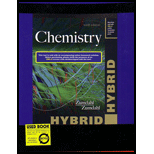
Concept explainers
Hydrogen peroxide is used as a cleansing agent in the treatment of cuts and abrasions for several reasons. It is an oxidizing agent that can directly kill many microorganisms; it decomposes on contact with blood, releasing elemental oxygen gas (which inhibits the growth of anaerobic microorganisms); and it foams on contact with blood, which provides a cleansing action. In the laboratory, small quantities of hydrogen peroxide can be prepared by the action of an acid on an alkaline earth metal peroxide, such as barium peroxide:
What mass of hydrogen peroxide should result when 1.50 g barium peroxide is treated with 25.0 mL hydrochloric acid solution containing 0.0272 g HCI per mL? What mass of which reagent is left unreacted?
Interpretation: The amount of hydrogen peroxide that can be produced by the given chemical reaction is to be calculated. The mass of the unreacted reagent is to be calculated.
Concept introduction: The mass of a substance can be obtained by using the number of moles of the substance present and its molar mass. The formula used to calculate the mass of a given substance is,
To determine: The mass of hydrogen peroxide that can be produced by the given chemical reaction and the mass of the unreacted reagent.
Answer to Problem 119E
The amount of hydrogen peroxide that can be produced is
Explanation of Solution
To determine: The mass of hydrogen peroxide that can be produced by the given chemical reaction
Given
The stated chemical reaction is,
The given mass of
The given volume of
The solution contains
The molar mass of
Formula
The number of moles of a substance is calculated by the formula,
Substitute the value of the given mass and the molar mass of
The solution contains
Therefore, the mass of
The molar mass of
According to the stated reaction,
The moles of
Therefore, some amount of
Barium oxide
According to the stated reaction,
Molar mass of
The mass of a substance is calculated by the formula,
Substitute the value of the number of moles of
To determine: The unreacted amount of the starting material.
Given
The stated chemical reaction is,
The given mass of
The given volume of
The solution contains
The molar mass of
Formula
The number of moles of a substance is calculated by the formula,
Substitute the value of the given mass and the molar mass of
According to the stated reaction,
The moles of
Therefore, some amount of
The moles of
Substitute the values of the given moles of
Molar mass of
The mass of a substance is calculated by the formula,
Substitute the value of the number of moles of
The amount of hydrogen peroxide that can be produced is
The unreacted reagent is
Want to see more full solutions like this?
Chapter 3 Solutions
Chemistry with Access Code, Hybrid Edition
- What is the final product when D-galactose reacts with hydroxylamine?arrow_forwardIndicate the formula of the product obtained by reacting methyl 5-chloro-5-oxopentanoate with 1 mole of 4-penten-1-ylmagnesium bromide.arrow_forwardIn the two chair conformations of glucose, the most stable is the one with all the OH groups in the equatorial position. Is this correct?arrow_forward
- please help me with my homeworkarrow_forwardhelparrow_forwardThe temperature on a sample of pure X held at 1.25 atm and -54. °C is increased until the sample boils. The temperature is then held constant and the pressure is decreased by 0.42 atm. On the phase diagram below draw a path that shows this set of changes. pressure (atm) 2 0 0 200 400 temperature (K) Xarrow_forward
- QUESTION: Answer Question 5: 'Calculating standard error of regression' STEP 1 by filling in all the empty green boxes *The values are all provided in the photo attached*arrow_forwardpressure (atm) 3 The pressure on a sample of pure X held at 47. °C and 0.88 atm is increased until the sample condenses. The pressure is then held constant and the temperature is decreased by 82. °C. On the phase diagram below draw a path that shows this set of changes. 0 0 200 temperature (K) 400 аarrow_forwarder your payment details | bar xb Home | bartleby x + aleksogi/x/isl.exe/1o u-lgNskr7j8P3jH-1Qs_pBanHhviTCeeBZbufuBYT0Hz7m7D3ZcW81NC1d8Kzb4srFik1OUFhKMUXzhGpw7k1 O States of Matter Sketching a described thermodynamic change on a phase diagram 0/5 The pressure on a sample of pure X held at 47. °C and 0.88 atm is increased until the sample condenses. The pressure is then held constant and the temperature is decreased by 82. °C. On the phase diagram below draw a path that shows this set of changes. pressure (atm) 1 3- 0- 0 200 Explanation Check temperature (K) 400 X Q Search L G 2025 McGraw Hill LLC. All Rights Reserved Terms of Use Privacy Cearrow_forward
 Introductory Chemistry: A FoundationChemistryISBN:9781337399425Author:Steven S. Zumdahl, Donald J. DeCostePublisher:Cengage Learning
Introductory Chemistry: A FoundationChemistryISBN:9781337399425Author:Steven S. Zumdahl, Donald J. DeCostePublisher:Cengage Learning General Chemistry - Standalone book (MindTap Cour...ChemistryISBN:9781305580343Author:Steven D. Gammon, Ebbing, Darrell Ebbing, Steven D., Darrell; Gammon, Darrell Ebbing; Steven D. Gammon, Darrell D.; Gammon, Ebbing; Steven D. Gammon; DarrellPublisher:Cengage Learning
General Chemistry - Standalone book (MindTap Cour...ChemistryISBN:9781305580343Author:Steven D. Gammon, Ebbing, Darrell Ebbing, Steven D., Darrell; Gammon, Darrell Ebbing; Steven D. Gammon, Darrell D.; Gammon, Ebbing; Steven D. Gammon; DarrellPublisher:Cengage Learning Chemistry: An Atoms First ApproachChemistryISBN:9781305079243Author:Steven S. Zumdahl, Susan A. ZumdahlPublisher:Cengage Learning
Chemistry: An Atoms First ApproachChemistryISBN:9781305079243Author:Steven S. Zumdahl, Susan A. ZumdahlPublisher:Cengage Learning Chemistry: The Molecular ScienceChemistryISBN:9781285199047Author:John W. Moore, Conrad L. StanitskiPublisher:Cengage Learning
Chemistry: The Molecular ScienceChemistryISBN:9781285199047Author:John W. Moore, Conrad L. StanitskiPublisher:Cengage Learning Chemistry for Engineering StudentsChemistryISBN:9781337398909Author:Lawrence S. Brown, Tom HolmePublisher:Cengage Learning
Chemistry for Engineering StudentsChemistryISBN:9781337398909Author:Lawrence S. Brown, Tom HolmePublisher:Cengage Learning





